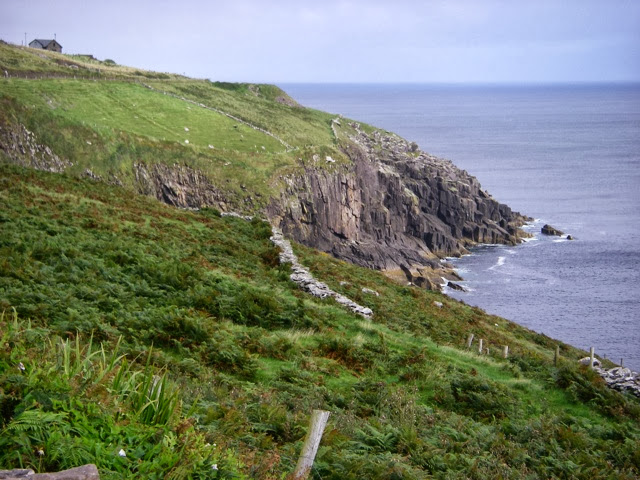Warning: this is mostly about cars and racing. And Fred said I had to add a bunch of pictures. :-)


The Revival is a celebration of races that took place at the Goodwood Motor Circuit from the fifties to the sixties. It's a party where you think you've been transported back in time. All of the cars, the service vehicles inside the track, and the clothing of many of the spectators are from that era.

Even the mechanics wear vintage clothing:
For the Revival, we flew from Dublin to Gatwick Airport and then drove our rental car to Bognor Regis, where we were staying, about 50 miles. We drove through 35 roundabouts!!!
Bognor Regis is a small beach town on the southern coast and about nine miles from the Goodwood Motor Circuit where the Goodwood Revival is held. This is the closest we've ever stayed to Goodwood. (Unfortunately, the blue sky you see below was from Monday after the races.)
The Goodwood Motor Circuit is a road course built on an old airport. It's the perfect place for the Revival. All the vehicles inside the confines of the track have to be period vehicles. So, the tow vehicles, the food trucks and the people haulers are all vintage. Vintage airplanes take off from and land on the infield during the event (though not usually while racing is going on) and fly low overhead.

We met up with our friends Jaime and Whitney from Alexandria, who were fully into the costume mode. Here's a picture of Jaime in all his glory:


And Fred with Jaime and Whitney, who had just had her hair done. (I took this with Jaime's iPhone--thanks to Jaime for sending it to me!)
Between the races, the people and the air show, we never know where to look when we're at Goodwood. Below, part of the airshow--a P-51 Mustang and a British Spitfire.
On Friday, the highlight was watching the Minis qualify in the St Mary's Trophy for "Saloons of the type that raced between 1960 and 1966." (Saloon is British for Sedan.) They are grouped together regardless of size, engine displacement or class. Note the Ford Galaxie, the Cortina and the Alfa in the pic below. It was a damp track that was made for the Minis. (Why is it Ford Galaxie and not Galaxy?)
Unfortunately, by the end of the day it started raining rather hard, and for safety reasons, the scheduled 90-minute final race was called after an hour.
Though not soon enough for this 1951 HW Alta-Jaguar (3.4L), which hit the wall right in front of where we were watching. Note the lack of roll bar. Modern roll bars are not required. As far as we know, the driver was a bit stunned but otherwise OK.
Even though the race ended early, it was dark (and still raining) as we walked to our car.
And walked. And walked. Even though, in the morning, we had carefully noted the row number where our car was parked, we exited the track into a different lot entirely and could not find the car! After much walking and asking for help while getting wetter and wetter, we finally saw the headlights flash in the distance when we tried the key remote. Note to Goodwood: have the row number start with the letter name of the lot. Note to ourselves: pay more attention.
On Saturday, it was still damp but not as rainy as the day before. The racing was fantastic.

The St Mary's Trophy, where the Minis race, was fabulous, but I think the highlight for Fred was to see twenty-six Ford GT40s race together. The start of that race, shown below:
A fun moment was being waved into the private paddock area by one of the paddock officials after Fred asked if he couldn't turn his back for a second. LOL, it worked! We got some awesome pictures.
There was a lot of red paint everywhere. Maseratis...
A green Ferrari in the midst of all that red? Say it ain't so!
GT40 after GT40. Fred was swooning.
C-Types. I was swooning...
This one won its race.

As at any race circuit, the work goes on between races.
British F1 World Champion Jim Clark's Lotus-Climax 21. Fred saw him race in this car at Watkins Glen in 1961, in the first Formula One race Fred ever saw. The tribute to Jim Clark at Goodwood was fantastic. Clark co-holds the Goodwood course record, set in 1965, in a Lotus-Climax 25 (with Jackie Stewart in a BRM).
We had a great time both days watching the cars at the first turn and enjoying our picnic lunch. Below, the obligatory photo of Fred eating.
The fans were riveted. (To the racing, not to Fred eating.)
This was our fourth Goodwood Revival, and while it was great, the event has gotten huge. One could hardly move on the circuit grounds. However, I still say it is the single best automotive event I've ever been to. (I probably should stop telling people that--too many people are listening to me!) The racing is simply fantastic. The drivers race the cars "as if they stole them" as the saying goes. And the cars themselves--it's hard to believe some of these cars are still around, let alone out there on the track. And the airplanes.... And the spectator clothing.... Sigh...
If you want to go, get your tickets early and your lodging earlier. The event sold out by mid-August this year.
Next: Portsmouth and the Mary Rose.


























































